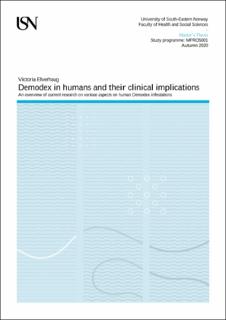| dc.description.abstract | Background
Demodex is a common and obligatory human ecto-parasite found predominantly in the facial area where active sebum secretion creates a suitable environment and breeding conditions (Lacey et al., 2009; Zhong et al., 2019). Two species of Demodex are found in humans, D. folliculorum and D. brevis. In some cases, Demodex infestations become pathogenic, often with a multifactorial origin. An infestation with a high mite density could cause various ocular and epidermal symptoms and signs, in some cases to a severe and possibly debilitating degree.
Objective
The purpose of this literature review is to gather the current and latest research on human Demodex in one review, providing a helpful tool for further research. Another aim of this review is to draw attention to this subject, as well as provide knowledge of this subject to more clinicians to decrease the risk of misdiagnosis and prescribing unnecessary and ineffective treatment therapies. Demodex infestations can resemble other disorders and can easily be over-looked as a primary or secondary cause in various epidermal and ocular diseases.
Methods
A literature search was conducted through Embase, Medline and PubMed, including articles in English or with satisfactory English abstract published from 2000 to May 2020. The search included various types of study designs, as this literature review focuses on providing an overview of all current Demodex research and findings.
Results
The literature search provided a substantial amount of information on various aspects of a Demodex infestation. These included classification and physiology of the mite, methods of diagnosis and detection, signs and symptoms, risk factors, the mite’s pathogenic potential, as well as correlations with the host inflammatory and immune response and the link to immune suppression. Correlations with dry eye disease, other ocular disorders and skin disorders, current and newer treatment options, as well zoonotic potentials of the mite are also discussed. Demodex are in most cases regarded as a commensal, though has the potential to turn pathogenic when in high densities (Fromstein et al., 2018). In these cases, patients may develop ocular and/or skin related symptoms and signs, though there are uncertainties concerning the exact process. Further research regarding the epidemiology, biology, molecular composition and pathology of the mite are warranted, as well as further research on the mites correlation with dry eye disease, the process of induced inflammatory and immune responses, treatment therapies and a possible zoonotic potential of the mite.
Limitations
This literature review merely provides an overview on the current research on human Demodex. The various aspects of this subject should be researched and discussed further in future studies. The review includes various study designs, including a few case reports, with articles of varying quality. Critical evaluation of the research has not been conducted in this review. There are also contradictions among different researchers, substantiating the need for further studies. To ensure the validity of the current research, more systematic reviews and meta-analysis are warranted.
Conclusion
Demodex infestations are often of a multifactorial origin, and may be dependent on skin type, environment, hygiene, immune status, the host inflammatory and immune response as well as several other factors. Demodex is linked to a number of skin and ocular diseases and could be an important differential diagnosis in various diseases. Knowledge regarding these mites are of importance to provide correct diagnosis and effective treatment therapies. | en_US |
